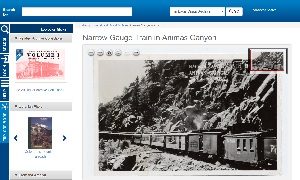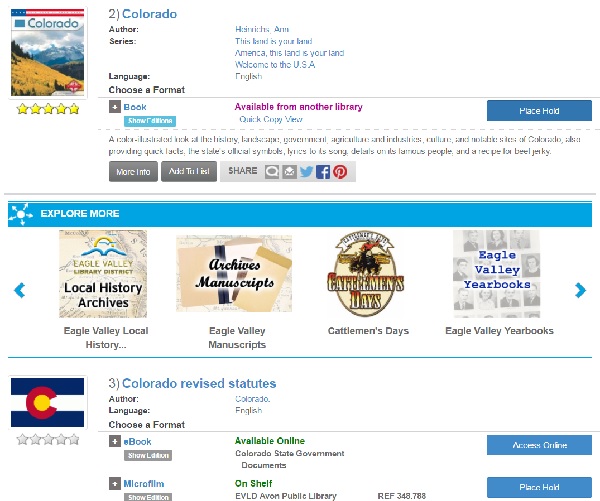2018 School Spending Survey Report
Marmot Launches Digital Archive
Marmot Library Network has developed a Digital Archive and repository solution, enabling its member libraries to showcase digitized collections of images, postcards, books, magazines, videos, recorded oral histories, music, and academic research. Users can discover archive content from throughout the multi-type consortium with a simple catalog search.
 Marmot Library Network, the multi-type consortium based in Grand Junction, CO, has developed a Digital Archive and repository solution, enabling its member libraries to showcase digitized collections of images, postcards, books, magazines, videos, recorded oral histories and music, academic research, and more. Using Islandora for administration, and Marmot’s own Pika resource portal and discovery layer (a fork of VuFind), the new solution is designed to surface archive content alongside related books, ebooks, DVDs, and other content when patrons conduct searches of their library’s catalog. Member libraries can also create custom online exhibits to highlight specific collections. Online exhibits began launching in August 2016, and this spring Marmot released an update enabling libraries to share combined collections of related archive content throughout the network. “Each Marmot library can maintain ownership (and limit access, as appropriate) of any collection, but the whole collection is a regional resource where persons, places, and events that appear in multiple collections are linked,” explained Jimmy Thomas, Marmot’s executive director. “A clean, responsive user interface with integrated viewers and players for lots of media types allows archive objects to be discovered in the catalog without impeding normal online catalog use cases. You should see the creative treatments of complex objects like the "Vail Quilt,” where each [quilt] panel is linked to relevant objects, and “Three-Wire Winter,” a journal of local history and culture, with linked audio files, transcripts, and other objects.” The project began about three years ago, when “a critical mass” of Marmot library directors identified the need for a digital repository solution. A task force was formed in September 2014 to evaluate the needs of members and examine solutions employed by other institutions, and in August 2015 Marmot hired Jordan Fields as program manager, to work with Marmot’s R&D manager Mark Noble and developer Pascal Brammeier, to create the Digital Archive. “The idea was to take digital collections…and get them out of the completely different systems that they were in, like CONTENTdm, or [various] institutional repository systems,” Fields explained. Another goal, she said, was to integrate this content into catalog search results in a way that made it discoverable and visible, without crowding out books and other content that patrons would typically be looking for. The solution is an “Explore More” carousel display that presents related content from the archives as a single search result. For example, searching the Eagle Valley Library District’s catalog for “World War II” returns a concise nonfiction history title as the first result, Laura Hillenbrand's bestseller Unbroken as the second result, and in between the second and third result, an “Explore More” carousel highlighting images, newspapers, local history collections, oral histories, and more from the Digital Archive. Clicking on one of these categories, such as “images,” navigates to the library’s local Digital Archive collection, applying the “World War II” search term and a filter to surface only images. When users are navigating Digital Archive search results, the “Explore More” carousel displays related books, DVDs, and other traditional content from the catalog. The feature makes Digital Archive content both prominent and unobtrusive, in a way that resembles Google’s integration of location-based areas of interest or related top news stories into its general search results. “That was the idea,” Fields said. “We tried to think of what our patrons were already used to, so that it would feel familiar to them…. We don't want to put anything in their face. [So] what we have is the Explore More bar. And that includes a mixture of objects as well as entities—people, places, events, organizations…. I think if we had created some kind of federated interface where these objects were mixed in, it would be really confusing to users.” In addition, the year-long development process began with input from librarians throughout the network regarding their expectations for the Digital Archive. “We spent a whole day doing a requirements workshop with all of our librarians,” Noble said. “We all sat down and threw [around] ideas for what people wanted to get out of the archive, and came up with different requirements…. We [also] did some pretty extensive mockups with a graphic designer beforehand, as an idea to see what we might want, as well as get people on board, so all of the different libraries, as we were proposing this project, could see what the interface might look like.” The archive has already drawn the attention of local newspapers. In April, the editors of Steamboat Springs, CO–based Steamboat Today wrote of the online revival of Three Wire Winter, “we think it's incredibly exciting that the very words of some of Steamboat and Routt County's most celebrated citizens, once trapped inside decades-old cassette tapes, are now accessible to the world thanks to the digital age and the vision of library and museum staff…. There's something serendipitous about converting this source material, which included oral histories on cassette tapes and magazine stories on paper, and making them available to a new audience on a robust and highly accessible website.” In fact, online access to Three Wire Winter has inspired a local high school to relaunch the journal and oral history project beginning next year, according to Steamboat Today.
Marmot Library Network, the multi-type consortium based in Grand Junction, CO, has developed a Digital Archive and repository solution, enabling its member libraries to showcase digitized collections of images, postcards, books, magazines, videos, recorded oral histories and music, academic research, and more. Using Islandora for administration, and Marmot’s own Pika resource portal and discovery layer (a fork of VuFind), the new solution is designed to surface archive content alongside related books, ebooks, DVDs, and other content when patrons conduct searches of their library’s catalog. Member libraries can also create custom online exhibits to highlight specific collections. Online exhibits began launching in August 2016, and this spring Marmot released an update enabling libraries to share combined collections of related archive content throughout the network. “Each Marmot library can maintain ownership (and limit access, as appropriate) of any collection, but the whole collection is a regional resource where persons, places, and events that appear in multiple collections are linked,” explained Jimmy Thomas, Marmot’s executive director. “A clean, responsive user interface with integrated viewers and players for lots of media types allows archive objects to be discovered in the catalog without impeding normal online catalog use cases. You should see the creative treatments of complex objects like the "Vail Quilt,” where each [quilt] panel is linked to relevant objects, and “Three-Wire Winter,” a journal of local history and culture, with linked audio files, transcripts, and other objects.” The project began about three years ago, when “a critical mass” of Marmot library directors identified the need for a digital repository solution. A task force was formed in September 2014 to evaluate the needs of members and examine solutions employed by other institutions, and in August 2015 Marmot hired Jordan Fields as program manager, to work with Marmot’s R&D manager Mark Noble and developer Pascal Brammeier, to create the Digital Archive. “The idea was to take digital collections…and get them out of the completely different systems that they were in, like CONTENTdm, or [various] institutional repository systems,” Fields explained. Another goal, she said, was to integrate this content into catalog search results in a way that made it discoverable and visible, without crowding out books and other content that patrons would typically be looking for. The solution is an “Explore More” carousel display that presents related content from the archives as a single search result. For example, searching the Eagle Valley Library District’s catalog for “World War II” returns a concise nonfiction history title as the first result, Laura Hillenbrand's bestseller Unbroken as the second result, and in between the second and third result, an “Explore More” carousel highlighting images, newspapers, local history collections, oral histories, and more from the Digital Archive. Clicking on one of these categories, such as “images,” navigates to the library’s local Digital Archive collection, applying the “World War II” search term and a filter to surface only images. When users are navigating Digital Archive search results, the “Explore More” carousel displays related books, DVDs, and other traditional content from the catalog. The feature makes Digital Archive content both prominent and unobtrusive, in a way that resembles Google’s integration of location-based areas of interest or related top news stories into its general search results. “That was the idea,” Fields said. “We tried to think of what our patrons were already used to, so that it would feel familiar to them…. We don't want to put anything in their face. [So] what we have is the Explore More bar. And that includes a mixture of objects as well as entities—people, places, events, organizations…. I think if we had created some kind of federated interface where these objects were mixed in, it would be really confusing to users.” In addition, the year-long development process began with input from librarians throughout the network regarding their expectations for the Digital Archive. “We spent a whole day doing a requirements workshop with all of our librarians,” Noble said. “We all sat down and threw [around] ideas for what people wanted to get out of the archive, and came up with different requirements…. We [also] did some pretty extensive mockups with a graphic designer beforehand, as an idea to see what we might want, as well as get people on board, so all of the different libraries, as we were proposing this project, could see what the interface might look like.” The archive has already drawn the attention of local newspapers. In April, the editors of Steamboat Springs, CO–based Steamboat Today wrote of the online revival of Three Wire Winter, “we think it's incredibly exciting that the very words of some of Steamboat and Routt County's most celebrated citizens, once trapped inside decades-old cassette tapes, are now accessible to the world thanks to the digital age and the vision of library and museum staff…. There's something serendipitous about converting this source material, which included oral histories on cassette tapes and magazine stories on paper, and making them available to a new audience on a robust and highly accessible website.” In fact, online access to Three Wire Winter has inspired a local high school to relaunch the journal and oral history project beginning next year, according to Steamboat Today. 
A search of a Marmot library's catalog showcases related content from the Digital Archive with an "Explore More" carousel.
RELATED
RECOMMENDED
TECHNOLOGY
ALREADY A SUBSCRIBER? LOG IN
We are currently offering this content for free. Sign up now to activate your personal profile, where you can save articles for future viewing









Add Comment :-
Comment Policy:
Comment should not be empty !!!